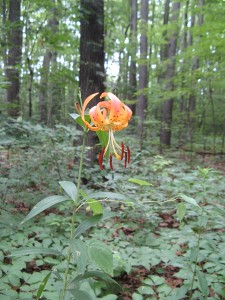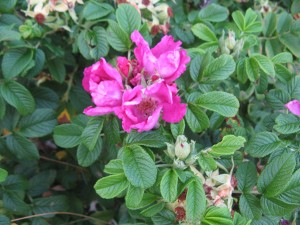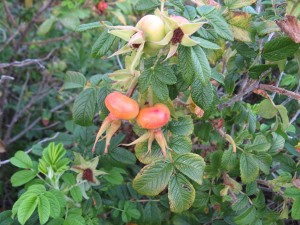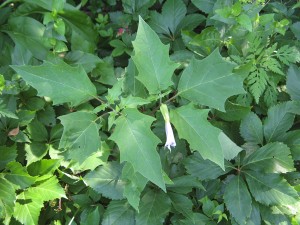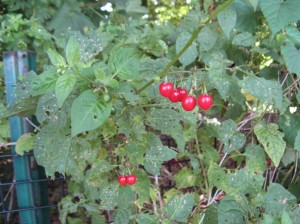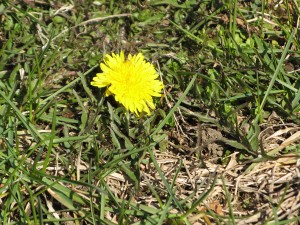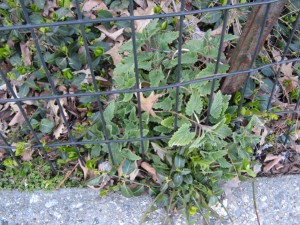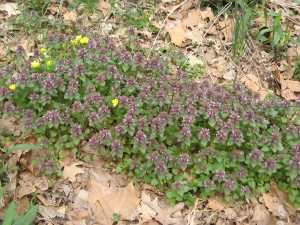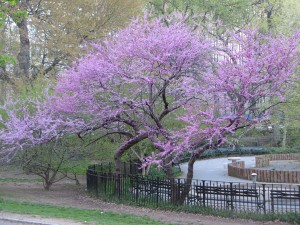HRT 300 – INTRODUCTION TO PLANT SCIENCE
Gary Lincoff (212-662-2651)(Gary@noahsquark.com)
Seven Thursdays beginning Thursday, April 4, 2013
Clock Hours: 16
Prerequisites: none
Required:
“Botany for Gardeners,” Revised edition. Brian Capon. Timber Press. 2nd or 3rd edition.
Chapter 1: Cells and Seeds: Basics and Beginnings
Chapter 2: Roots & Shoots: How Plants Mature
Chapter 3: Inside Stems
Chapter 4: Inside Roots and Leaves
Chapter 5: Adaptations for Protection
Chapter 6: Adaptations to Fulfill Basic Needs
Chapter 7: Control of Growth and Development
Chapter 8: The Uptake & Use of Water, Minerals & Light
Chapter 9: From Flowers to Fruits
Chapter 10: Strategies of Inheritance
Recommended:
“Essential Atlas of Botany,” Barron’s Educational Series, 2004. [to be browsed at your leisure]
Chapters:
Plant Anatomy
Plant physiology
Reproduction
Ecology and Evolution
Algae
Fungi
Plants
Plants and their Environment
Wild Plants and Humans
Plants for Production
Course Description: This course surveys the major groups of plants in the broadest sense, including flowering plants, conifers, ferns, bryophytes, algae, and fungi. – focusing on form and function. We will study their ecology, systematics and evolution. Gain practical experience in dissecting and analyzing plant structures.
Objectives: Each student will keep a daily journal of plant ‘events’ (what’s seen, changes over time, etc.), and each will put together a collection of plant pressing made during the time of the course. In addition, each student will be able to explain in ‘plain English’ the basic concepts of botany.
COURSE OUTLINE
Class 1: Introduction. Assignment: Start reading “Botany for Gardeners.”
Class 2: Examine specimens. Discuss Ch. 1 & 2.
Class 3: Examine specimens. Take quiz. Chapters 3 & 4
Class 4: Examine specimens. Discuss Chapters 5 & 6
Class 5: Examine specimens. Discuss Chapters 5 & 6
Class 6: Examine specimens. Take quiz. Discuss Ch. 7 & 8
Class 7: Examine specimens. Discuss Ch. 9 & 10. Review course.
Class 8: Final Exam
INSTRUCTION METHODS Each class will begin with a different set of plant specimens to be examined, followed by a quiz (on at least 2 of the dates) based on the reading assigned. This will be followed by an illustrated lecture and class discussion.
Grading: How students will be evaluated and what percentage each item will count towards the final grade for course.
Lab notebook 15%
Quizzes 30%
Journal 15%
Plant pressings 15%
Final Exam 25%
Attendance: Attendance is required; unexcused tardiness and absences are not accepted; excused tardiness and absences will be evaluated on a case by case basis. Make up quizzes and exams must be requested by student and will be scheduled at the instructor’s convenience.
- – - – - – - – - – - – - – - – - – - – - – — – - - – — – - - – -
SOME BOOKS THAT WILL BE DISCUSSED IN THIS COURSE
Barlow, Connie. “The Ghosts of Evolution: Nonsensical fruit, missing partners, and other ecological anachronisms.”
Barnard, Edward. “New York City Trees: A field guide for the metropolitan area.”
Bernhardt, Peter. “Wily Violets and Underground Orchids.”
Duke, James. “The Green Pharmacy”
Graves, Arthur H. “Illustrated Guide to Trees and Shrubs: A Handbook of the Woody Plants of the Northeastern United States and Adjacent Canada.”
Heywood, V.H. “Flowering Plants of the World.”
Holldobler, B. and E. O. Wilson. “The Leafcutter Ants: Civilization by Instinct”
Kricher, John. “Eastern Forests” (a Peterson field guide)
Newcomb, Lawrence. “Newcomb’s Wildflower Guide.”
Peterson, Roger T. “A Field Guide to Wildflowers of Northeastern and North-central North America.”
Pollan, Michael. “The Botany of Desire.”
Stewart, Amy. “Wicked Plants”
Uva, Richard, et al. “Weeds of the Northeast”
Yoon, Carol. “Naming Nature: the clash between instinct and science.”
- – - – - – - – - – - – - – - – - – - – - – - – - – - – - – - – - – -
10 PLANT FAMILIES YOU SHOULD KNOW:
skunk cabbage, 4/10/11, Teatown Reservation, Croton, NY”]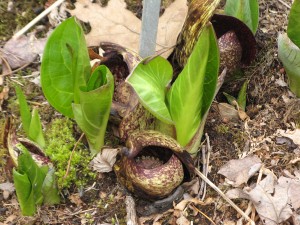
Questions about Skunk Cabbage: (1) What family is it in? (2) Where does it grow? (3) When does it appear? (4) How does it get pollinated? (5) What is the unique secondary metabolite common to this family of plants? (6) Are any plants in this family used for food, and if so, by whom, and how?
“What is the plant composing the lawn?”]
Questions: (1) What is this plant called? (2) What family is it in? (3) What is it related to? (4) Are any plants in this family edible; and, if so, which ones and how?
Questions: (1) What is this plant called? (2) What family is it in? (3) What other plants are in this family? (4) Are any of these plants edible; and, if so, which ones?
What kind of plant is this? It’s a woody shrub. Look at the leaves, the flowers, and the fruit.
What plants are these? What family do they belong to? What else is in this family? Are any plants in the family edible?
Dandelion, of course, but what family is it in? What else is in this family? Is anything in this family edible?]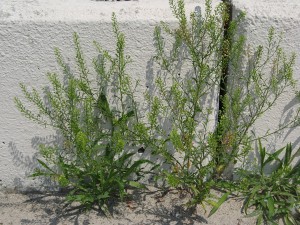
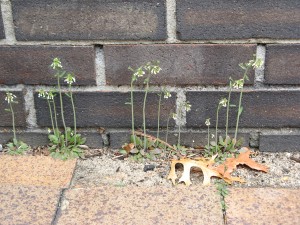
What family is peppergrass (left) and Draba (right) in? What else is in this family?
What family are catnip and Lamium in? What else is in this family? What family plants do you use?
What family does this look like?”]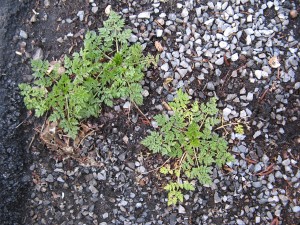
What family is redbud in? What else is in this family? What do you eat that’s in this family?
10 Plant Families to learn:
MONOCOT FAMILIES:
Arum Family (Araceae)
Grass Family (Poaceae)
Lily Family (Liliaceae)
DICOT FAMILIES:
Aster Family (Asteraceae)
Bean Family (Fabaceae)
Carrot Family (Apiaceae)
Mint Family (Lamiaceae)
Mustard Family (Brassicaceae)
Nightshade Family (Solanaceae)
Rose Family (Rosaceae)
[How do you distinguish between monocot and dicot families?]
Arum Family (Araceae)
This is a well-known and readily recognized family of flowering plants. The flower develops inside a spathe (leaf-like bract) and is called a spadix (appearing spike-like). The leaves can be either parallel-veined or net-veined (which is uncharacteristic for monocots). Arums contain calcium oxalate crystals which protect the plant by embedding themselves in the mouths of predators causing extreme pain. Edible arums include taro. Ornamental arums include Philodendron, Spathiphyllum and Anthurium. One dangerous household arum is called Dumbcane (Dieffenbachia). The world’s largest flower is an arum, the very phallic and malodorous Amorphophallus titantium.
Grass Family (Poaceae)
The Grass Family supports human life on the planet: nearly all of our staples are grasses (wheat, rice, corn, barley, oats), or the grasses provide the food for our livestock. The Grass Family is probably the most successful of all recently evolved flowering plant families. Its life cycle is very short, its vegetative growth is aggressive and strong-rooted, and a novel intercalary meristem allows it to be eaten down to the ground and grow back quickly. There are toxins in the Grass Family that poison cattle and horses. There is also a fungus that parasitizes grass fruits that produces ergot alkaloids that poison whole communities of people who eat bread made form ergotized grain.
Lily Family (Liliaceae)
The traditional Lily Family included all monocots (plants with parallel-veined leaves) with conspicuous bell-like flowers that have six parted flowers with six stamens and a long pistil ending in a 3-lobed stigma. Traditional lilies included the Alliums (onions, garlic, leek) as well as the Day-lilies. Now, except for Trilliums, most former Lily Family plants have been separated out into other, smaller or new families. Day-lilies, for example, while resembling true lilies, are much more closely related, based on DNA sequencing and seed-coat analysis, to asparagus and orchids than to lilies.
Aster Family (Asteraceae)
The Aster Family is the largest family of late summer and fall flowering herbaceous plants. These plants are also referred to as composites because the flowers, while appearing to be single, are composed of outer ray flowers (each with a stamen attached) and inner disk flowers (with pistils). Dandelion, daisy and thistle are three characteristic types of composites. The flowers are typically animal pollinated and the fruit is wind dispersed, like goldenrods and asters. Some, however, have wind-dispersed pollen, like ragweed, which causes ‘hayfever’ in late summer and fall. Food plants in this family include lettuce, artichokes, Jerusalem artichokes, sunflower, tarragon, salsify, chicory and endive. Toxins in this family have been made into insecticides. At least one poisonous Senecio species is responsible for a significant percentage of livestock losses. Compounds in wormwoods have been used in making absinthe, and one is now being used in making an effective anti-malarial medication.
Bean Family (Fabaceae)
One of the largest flowering plant families on the planet, and the most important ecologically: root nodules house soil bacteria that fix atmospheric nitrogen and change it into an organic compound that fertilizes the soil and is the main source of usable nitrogen on earth. Bean Family plants have 3 kinds of flowers but the primary one is zygomorphic (horizontally asymmetric). The fruit is a pod containing seeds, like peanuts and green beans. Tofu is made from the soybean, one of a very few non-Grass Family human staples. The bean family at least two kinds of toxins, a cardio-glycoside and a nerve damaging alkaloid.
Carrot Family (Apiaceae)
Carrots, parsnips, parsley, celery, fennel, dill, coriander, cumin, caraway and dill are all umbellifers (the former name of this family). Many umbellifers have medicinal uses while a few, like Poison Hemlock and Water Hemlock, are quite deadly. This family has umbrella-shaped clusters of flowers (called umbels), each flower with 5 petals. The fruit is typically dry, like carrot seed. The leaves are typically finely cut. There is a distinctive odor in many plants in this family, and some contain characteristic toxic alkaloids, coniine and cicutoxin.
Mint Family (Lamiaceae)
Mints include catnip, spearmint, peppermint, lavender, thyme, rosemary and sage. Mints also include a number of common weeds, like creeping charley, henbit and heal-all. Many mints have medicinal uses but poisonings from mint use, either too much or from extracts, have been reported, including seizures. Mints are easily recognized by having square stems, and opposite toothed simple leaves. The flowers are zygomorphic (horizontally asymmetrical) and often red or blue. The fruits are dry rather than fleshy.
Mustard Family (Brassicaceae)
Many of our cooked vegetables and salad greens are mustards. These include cabbage, broccoli, cauliflower, Brussels sprouts, kale, turnips, radish, watercress, and arugula. Garlic-mustard is an invasive destructive weed that can weaken and kill path side trees. Some mustard oils are used in cooking. Some mustard seeds are used in herbicides. The flowers have 4 petals, usually white or yellow, with 6 stamens. The fruits are small and either circular or needle-shaped and contain mostly black seeds. The roots are usually white.
Nightshade Family (Solanaceae)
The Nightshade Family includes our potatoes, tomatoes, eggplants, bell and chili peppers (but not black pepper), tomatillos, and tobacco. It also includes the deadly nightshade (Belladonna, Atropa belladonna), an infamous poisonous plant, Mandrake, and some plants that cause hallucinations (like Jimsonweed, Datura stramonium). The poisonous nature of the plants in this family can be remembering by calling to mind this mnemonic for anticholinergic symptoms: “blind as a bat, dry as a bone, red as a beet, hot as a hare, and mad as a hatter.” There are two kinds of flowers, one trumpet-shaped, like a Datura, the other more common one like the genus Solanum, which includes the potato and the woody nightshade. The fruit is either a berry (Solanum) or a capsule (Datura).
Rose Family (Rosaceae)
The Rose Family is the most conspicuous flowering plant family in our area. Many of our spring trees are flowering cherries or flowering crabs; many of our grocery store fruits are Rose Family plants, like strawberries, blackberries, raspberries, apples, pears, cherries and plums. The Rose Family is recognized by its perfect flowers (both male & female in same inflorescense) [5 sepals, 5 petals, many stamens, at least one pistil], by its typically simple, alternate, toothed leaves (with exceptions), by its fruit types, especially the pome (apple), and by its phytochemical signature [prussic acid causing cyanosis on ingestion].
LET’S LOOK AT THE ROSE FAMILY A LITTLE MORE CAREFULLY……….
The Rosaceae is a flowering plant family in the class traditionally known as the dicots. It has a worldwide distribution but is most common and diverse in the north temperate zone. There are more than 125 genera and more than 3,500 species recognized in this family. The family includes both woody and herbaceous plants. The plants are typically alternate branched, but there are exceptions: jetbead is opposite-branched. The leaves are typically simple, but there are many exceptions: roses and the blackberry-raspberries are compound leaved. The flowers have 5 petals, but Kerria can have doubled petals and flowering cherry cultivars can have 10, 20 or more petals. The family is usually divided into subgroups based on fruit types. One such subgroup has drupaceous fruit, and this includes cherries and plums and apricots. One subgroup has pomaceous fruit, and this includes apple, pear, crabapple, hawthorn, quince, and Amelanchier. [There's a rust fungus specific to this group of fruit trees & shrubs; the rust has a life cycle that includes juniper as its alternate host.] Another fleshy-fruited subgroup has aggregated fruits, and this includes the fleshy achenes of the strawberry and the drupelets of Rubus, the blackberry-raspberry genus. Some plants in the Rose Family have dry fruits rather than fleshy ones, and this includes plants like Geum. Rose, itself, has a distinctive fruit called a hypanthium; the outer covering actually only partially encloses the real fruits, which appear as hairy-bristly seeds when it’s opened. Although we eat many of the fruits in this family, and make tea from the dried leaves of several plants, there are secondary metabolites produced that can cause human poisoning. In addition to prussic acid in the leaves and seeds of many of the plants, some have a more distinctive poisoning profile. Spiraea, for example, contains toxic amounts of methyl-salicylate. (Google Spiraea to learn more.)
How many plants of all kinds are there on the planet? Approximately, 250,000 or so.
There are somewhat more than 400 plant families. Some are more diverse than others. Orchids, for example, have more than 25,000 species. The bean family has more than 18,000 species.
There are 4 major phyla of plants: Bryophytes (15,000), Pteridophytes (15,000), Gymnosperms (600+), Angiosperms (220,000). The Angiosperms are divided into 2 traditional groups (see below), the Monocots and the Dicots. There are approximately 70,000 monocots and150,000 dicots. The monocots evolved from some unknown group of dicots. The dicots evolved from some unknown group of Gymnosperms. The Gymnosperms evolved from some unknown group of ferns. The ferns did not evolve from the mosses. Both ferns and mosses evolved from unknown groups of green algae. The green algae evolved from an unknown group or groups of bacteria.
PLANT CLASSIFICATION
Plant species have names that are binomials, that is, they are, by convention and rule, composed of two names, as are all animal species. The first name is the genus. The second name is the species epithet. The species name is both, not just the species epithet.
A genus can have one or more species. Some genera have a great many species. A family, the next major rank in the hierarchy, is based on a genus, but it can contain several to many genera.
The hierarchy of classification is:
Kingdom
Phylum
Class
Order
Family
Genus
Species
The Plant Kingdom contains several PHYLA (plural of Phylum). One is the Angiosperms, a huge, conspicuous group of flowering plants with seeds enclosed within a fruit. Another is the Gymnosperms (primarily the conifers), a group of seed plants with naked seeds. A third is the Ferns (Pteridophytes), a group of vascular plants that produce spores instead of seeds. A fourth is the Bryophytes (primarily mosses), a group of non-vascular plants that produces spores instead of seeds. [Modern classification no longer recognizes the “gymnosperms,” as such, but does recognize distinct groups within the former “gymnosperms,” like the Pinophyta, the Ginkgophyta, etc. The “angiosperms,” or flowering plants, are sometimes referred to now as the Magnoliophyta. The standard nomenclatural rule nowadays is to base a higher taxon, whether a family, an order or a class on a concrete group of plants rather than a characteristic of those plants. The Leguminosae, for example, is now mostly referred to as the Fabaceae.
The ALGAE are now usually excluded from the Plant Kingdom because they lack embryos, a characteristic of all of the above groups. The green algae are believed to be the ancestral group of all plants. [We will look at the algae in a later class.]
The FUNGI are excluded from the Plant Kingdom because, among other things, they acquire their nutrients by distinctively different pathways. The fungi are believed to be more closely related to a primitive group ancestral to animals rather than to any plant group.
[We will study the fungi, so essential to understanding plant ecology, in another class.]
Among the Angiosperms, there are two traditionally recognized CLASSES: the monocots and the dicots. The monocots (monocotyledons) have a single cotyledon (seed leaf) in the seed, the leaves of most are parallel-veined, the flowers when conspicuous are 3 to 6 parted, and the roots are primarily horizontally extended. Monocots include the grasses, the lilies, the palms, the orchids and a number of small tropical families. The dicots include everything else, especially all woody plants. Dicots typically have net-veined leaves, 4 to 5 parted flowers, and tap roots. [Return to the list above of the Ten Plant Families to see examples of monocot and dicot plant families.]
The ORDERS of the monocots or dicots are important but usually only to researchers. The FAMILIES of monocots and dicots are important for plant identification because the families typically have morphological characteristics and biochemical profiles (secondary metabolites) that distinguish the plants they contains. The Rose Family, for example, is easily recognizable by most people because of its flowers, its fruit, and its vegetative structure.
A plant name is composed of two parts: the GENUS and the SPECIES.(the word species is both singular & plural). The names of plant species are sometimes difficult to understand. Prunus serotina is the species name for the Black Cherry, not the cherry of commerce, but the wild late fruiting wild weedy cherry. Prunus x subhirtella ‘Autumnalis’ is the Autumn Cherry. It’s our only cherry that flowers in the winter! It’s name refers to it being a HYBRID between two species one of which is Prunus subhirtella. The name ‘Autumnalis’ tells us it’s a CULTIVAR, that is, a grafted tree from a form of Prunus x subhirtella that flowers in late autumn-early winter.
MADcapHORSE
MADcapHORSE is a mnemonic that refers to all native trees and shrubs that have their leaves arranged opposite each other rather than alternating along a branch. MADcapHORSE stands for these families: Maple, Ash, Dogwood, cap (the honeysuckle family – Caprifoliaceae), and Horse-chestnut. The honeysuckle family includes Viburnum, honeysuckle and a number of honeysuckle-like shrubs. The Ash family includes, besides, ash trees, lilac, forsythia, privet, and others.
SIMPLE vs COMPOUND LEAVES
SIMPLE vs COMPOUND LEAVES. When the leaves are on woody plants, a simple leaf has a bud at its node, that is, where it or its petiole (stem) comes out from the branch. A compound leaf is composed of leaflets. A compound leaf is recognized as compound because its individual leaflets do not have buds at their nodes. Rather, the bud is at the base of the compound leaf. A compound leaf also typically has a terminal leaf, that is, the other leaflets can all be paired, but there is an unpaired terminal leaf at the apex.
ALTERNATE vs OPPOSITE BRANCHING
ALTERNATE vs OPPOSITE BRANCHING. Look for the buds or the main branching of the plant. If the buds are opposite each other, the plant is called ‘opposite-branched.’ If the buds are alternating on the branch, the plant is called ‘alternate-branched.’ You should look at several examples on a given plant to ascertain whether it is alternate or opposite branched.
PLANT CELLS
The plant cell has a number of important features. One is the cell wall, which is composed of cellulose, a long-chain polysaccharide, something very difficult to degrade. [Humans lack the enzyme to digest cellulose.] Inside the cell wall there is a membrane called the endoplasmic reticulum, which helps protect the contents of the cell from predators. The contents of the cell exist in a gell called cytoplasm. The most important components inside the cell are the nucleus, the chloroplasts, the mitochondria, the ribosomes and the vacuole. Each is protected by membranes. We can see the cell as an intricate package composed of endlessly active and interacting units doing a number of complex things from making more of itself (cell division), to making food (sugars), to transforming the sugars into energy units (respiration), to making enzymes and proteins, to getting rid of waste materials, to making toxins to protect itself against predators, etc. The individual cell in many ways is like a “super-organism.” Plants, unless algae are included in the Plant Kingdom, are multi-cellular. The cells have produce a pectin-like substance that allows cells to adhere together, and the cells have microscopic rods extending between them, which transmit chemical messages throughout the plant.
VASCULAR PLANTS
Roots are not just things that connect plants to the ground. Algae and mosses have things that do that but those things are not roots. They are holdfasts, rhizoids that just hold certain algae and mosses to a substrate. Roots do three things: they anchor the plant, they are the way water and nutrients come into the plant, and they store food. Roots are a vascular structure. So are stems and leaves. Roots, stems, and leaves contain vascular tissues called xylem and phloem. These are tubes that give a rigid structure to a plants, which couldn’t grow very high without them; but, more importantly, the xylem tubes are the vehicle for water to rise up through the plant and the phloem tubes move the sugars (transformed into an energy currency) around the plant for use in opening flowers, developing fruit, and storing energy for next year’s growth. Ferns, Gymnosperms and Angiosperms are vascular plants. In this sense, Algae and Mosses have no roots, no stems and no leaves, despite appearances. Algae and mosses get their nutrients through their leaves by osmosis. Vascular plants bring water into their roots by osmosis but then send the water to the xylem tubes by a kind of “root pressure” and send the water up to the top of the plant by a mechanism called “transpirational pull.” As water rises to the top or into the leaves, it is evaporated by heat and leaves the leaves as a gas, water vapor, through the millions of special cells under the leaves called stomata. As water leaves the plant, the vacuum is filled by new water rising up through the plant. Tallest plant: 400+ feet!
- – - – - – - – - – - – - – - – - – - – -
BOTANY FOR GARDENERS
GROWTH
CHAPTER 1. Cells and Seeds: Basics and Beginnings
CELLS
All living things are composed of one or more cells.
Words to know: protoplasm, cytoplasm, cytoplasmic membrane, nucleus, organelles, chloroplasts, mitochondria, ribosomes, vacuole, nucleus
CELL WALLS
As much as 98% of a tree’s trunk and branches are composed of dead cells
Words to know: pectin, cellulose
WALL STRUCTURE AND CELL GROWTH
Most cells in a plant grow in a specific direction.
GROWTH PROCESSES
Word to know: mitosis, chromosomes
Question: How many stages does mitosis involve?
MERISTEMS
Cells divide in areas called meristems.
Words to know: apical and lateral meristems
SEED COATS
Words to know: viable, dormancy, scarified
Know 5 ways in which seeds are or can be scarified.
FOOD-STORAGE STRUCTURES AND THE EMBRYO
Compared with dicots, monocots are believed to be the more recent products of plant evolution.
Know these words: cotyledon, embryo, endosperm.
SEED GERMINATION
Less than 2% of a seed’s weight is water, compared with about 95% water in a mature herbaceous plant.
…successful germination of arctic lupine seeds taken from frozen tundra soils and found to be 10,000 years old…
Know these words: herbaceous, imbibition, cellular respiration, heterotrophic & autotrophic nutrition
OTHER GERMINATION REQUIREMENTS
Know these words: allelopathy, stratification
CHAPTER 2. Roots and Shoots: How Plants Mature
ROOT SYSTEMS
Roots anchor the plant, they store food, and they serve as avenues of transport of water and soil nutrients into the plant.
Know these words: tap root and fibrous roots
ROOT GROWTH
A damaged meristem cannot be regenerated.
Know these words: root cap and root cap cells
ROOT HAIRS AND BRANCHES
All the root’s primary growth activities are concentrated in a region about ¼ inch long at its tip.
The width of the root hair zone remains constant.
PRIMARY GROWTH IN STEMS
A stem’s apical bud is within the uppermost 1/10 inch of the stem.
Know these words: apical bud, leaf primordial, axillary bud primordium, nodes and internodes.
Give an example of an alternate, an opposite and a whorled leaf arrangement.
What is the difference between a tree and a shrub?
DEVELOPMENT OF A WOODY TWIG
What are the advantages of having a plant’s leaves elevated by a woody structure?
FEATURES OF A WOODY TWIG
What are lenticels and leaf scars?
What do rings of terminal leaf scars show?
LEAVES
A full-sized leaf (of the Victoria water lily) can support a load of up to 165 pounds.
Know these words: simple vs compound leaves; pinnately compound vs palmately compound leaves
Differentiate crenate, dentate, serrate and doubly serrate leaf edges.
Name a plant group with an intercalary meristem. What does it mean?
ORGANIZATION
CHAPTER 3: INSIDE STEMS
Herbaceous Stems…..Dicot tissues (& recognizable parts): cuticle / epidermis / cortex / primary phloem / vascular cambium / primary xylem / pith
Question: What inside a monocot stem – from the outside to the center?
Stem Thickening…..What is the “cork cambium”?
Other Features of Wood…..What are vascular rays and what do they do?
Monocot Stems…..Note: there is no vascular cambium in monocots! “Trunk thickening in large monocots, such as palms, simply results from repeated formation of the scattered vascular bundle pattern.”
CHAPTER 4: INSIDE ROOTS AND LEAVES
A Root’s Primary Tissues…..Locate the root epidermis, cortex, endodermis, pericycle, primary xylem, vascular cambium, and primary phloem.
Secondary Growth in Roots…..How does water enter a root?
Cellular Organization in Leaves…..Locate the tissues in leaves: upper epidermis, palisade cells of the mesophyll, a plant vein, spongy cells of the mesophyll, the lower epidermis, the guard cells of the stomata, and the cuticle…..
Plant Cell Types…..What are parenchyma cells, and where are they located? What and where are stone cells?
ADAPTATION
CHAPTER 5: ADAPTATIONS FOR PROTECTION
The Garden Habitat: The Irish potato blight destroyed what percentage of the crop?
Centers of Origin of Agriculture: where in the world do peanuts come from?
Places of Origin of some Garden Plants: Where in the world does day-lily come from?
Protection in Extreme Environments: What do perennial plants in hot, dry deserts do during a drought?
Protection Against Animals: How do prickles differ from thorns?
Protection by Camouflage: What are “living stones”? Name one kind.
Protection by Ants: Several hundred plants are “protected” by ants: Name one.
Wound Healing: What is suberin?
Chemical Protection: What are tannins and how do they work?; Name 3 families containing alkaloids.
Mode of Operation of Chemical Protectants: What is penicillin and how does it work?
CHAPTER 6: ADAPTATIONS TO FULFILL BASIC NEEDS
Competition Between Plants: How does an abundance of water & minerals and a good climate make matters more difficult for plants?
Spreading Stems: What’s the difference between stolons, rhizomes, and suckers?
Climbing Structures: Give 3 examples of tendrils
Lianas and Epiphytes: How do lianas differ from epiphytes?
Supportive Roots: How do buttress roots differ from prop roots?
Special Methods of Water Uptake: How is water absorbed by Spanish Moss? (What is Spanish Moss?)
Adaptations for Water Storage: “As much as …% of the total volume of succulent plants is devoted to water storage.”
Underground Food and Water Storage Organs: How does a bulb differ from a corm?
Saprophytes and Parasites: Dodder and mistletoe are both plant parasites: how do they differ?
Mycorrhizae and Root Nodules: Do mycorrhizae occur in both monocots & dicots? Name a soil bacterium involved in nitrogen fixation.
Insectivorous Plants: Name 3 different kinds of traps plants use to capture insects.
FUNCTIONS
CHAPTER 7: control of growth and development
Plant Hormones
Functions of Auxin
* Stimulates cell elongation
* Stimulates cell division in the cambium and, in combination with cytokinins in tissue culture
* Stimulates differentiation of phloem and xylem
* Stimulates root initiation on stem cuttings and lateral root development in tissue culture
* Mediates the tropistic response of bending in response to gravity and light
* The auxin supply from the apical bud suppresses growth of lateral buds
* Delays leaf senescence
* Can inhibit or promote (via ethylene stimulation) leaf and fruit abscission
* Can induce fruit setting and growth in some plants
* Involved in assimilate movement toward auxin possibly by an effect on phloem transport
* Delays fruit ripening
* Promotes flowering in Bromeliads
* Stimulates growth of flower parts
* Promotes (via ethylene production) femaleness in dioecious flowers
* Stimulates the production of ethylene at high concentrations
Functions of Cytokinin
* Stimulates cell division.
* Stimulates morphogenesis (shoot initiation/bud formation) in tissue culture.
* Stimulates the growth of lateral buds-release of apical dominance.
* Stimulates leaf expansion resulting from cell enlargement.
* May enhance stomatal opening in some species.
* Promotes the conversion of etioplasts into chloroplasts via stimulation of chlorophyll synthesis.these other compounds arise.
Functions of Gibberellins
* Stimulate stem elongation by stimulating cell division and elongation.
* Stimulates bolting/flowering in response to long days.
* Breaks seed dormancy in some plants which require stratification or light to induce germination.
* Stimulates enzyme production (a-amylase) in germinating cereal grains for mobilization of seed reserves.
* Induces maleness in dioecious flowers (sex expression).
* Can cause parthenocarpic (seedless) fruit development.
* Can delay senescence in leaves and citrus fruits.
Functions of Ethylene
* Stimulates the release of dormancy.
* Stimulates shoot and root growth and differentiation (triple response)
* May have a role in adventitious root formation.
* Stimulates leaf and fruit abscission.
* Stimulates Bromiliad flower induction.
* Induction of femaleness in dioecious flowers.
* Stimulates flower opening.
* Stimulates flower and leaf senescence.
* Stimulates fruit ripening.
Functions of Abscisic Acid
* Stimulates the closure of stomata (water stress brings about an increase in ABA synthesis).
* Inhibits shoot growth but will not have as much affect on roots or may even promote growth of roots.
* Induces seeds to synthesize storage proteins.
* Inhibits the affect of gibberellins on stimulating de novo synthesis of a-amylase.
* Has some effect on induction and maintanance of dormancy.
* Induces gene transcription especially for proteinase inhibitors in response to wounding which may explain an apparent role in pathogen defense.
CHAPTER 8: The uptake and use of water, minerals, and light
OSMOSIS: THE CELL’S WATER PUMP
During osmosis, water molecules attempt to equalize their concentration on both sides of cell membranes when they move into or out of living protoplasm.
Q: does water coming into the roots move into or between cortex cells?
DEVELOPMENT OF ROOT PRESSURE
Together, the epidermal and endodermal pumps push water across the root and up the xylem with a slight pressure, called root pressure.
Q: Do these pumps use a) imbibition, b) osmosis, or c) transpirational pull?
TRANSPIRATIONAL PULL
A 48 -foot silver maple is estimated to transpire as much as 58 gallons per hour.
Q: Name a couple of ways in which plants can reduce water loss through transpiration.
Q: After transplanting, to help a plant recover from the move, it should be a) well watered immediately after transplanting, or b) watered only after it has had time to rest from the move.
COLD HARDENING
Cold hardening involves the accumulation in the protoplasm of sugars that function as antifreeze. It also changes the permeability of cell membranes, allowing water to leak into intercellular spaces.
What is peat? How is it made? Why does it last?
MINERAL NUTRIENT NEEDS
Mineral deficiencies:
Magnesium deficiency: yellowing of the older leaves
Iron deficiency: yellowing of young leaves
Nitrogen deficiency: weak stems, undeveloped leaves, reduced root
development
Phosphorus deficiency: retards growth of all plant parts
Calcium deficiency: impairs pectin formation
Chlorophyll a : C(55) H(72) O(5) N(4) Mg
Q: How many atoms are in the chlorophyll a molecule?
Q: NPK ratio: a 0-10-10 ratio is designed for a) root crops, b) leaf growth or c) flower and fruit set.
SOILS
Some cultivated hydrangea flowers can be blue or pink, depending on soil pH.
Q: blue flowers indicate a) alkaline soil or b) acidic soil ?
THE PHOTOSYNTHETIC APPARATUS
A purple-red pigment, called anthocyanin, occurs in the roots, stems, leaves, flowers and fruits of vascular plants, but it does not participate in photosynthesis because a) it is stored in a) the nucleus, b) the vacuole, or c) the ribosomes.
Q: What does anthocyanin do? A: It can act as a sunscreen for leaves, act as a color attractant in fruit, etc.
LIGHT TRANSFORMED INTO THE ENERGY IN FOOD
Cellular respiration occurs in the cell’s mitochondria.
Autotrophic plants hold the key to life on Earth: True or False?
THE PHOTOSYNTHETIC PROCESS
Photosynthesis takes place in two stages.
In the light reaction, water molecules are split to acquire hydrogen electrons to fuel the “dark reaction,” called carbon dioxide fixation, which produces complex sugars.
Water (from the soil) + Carbon Dioxide (from the atmosphere) [in the presence of sunlight and chlorophyll] = Sugar + Oxygen (O2)……..oversimplified but memorable
GAS EXCHANGE WITH THE ATMOSPHERE
Q: Yeasts reduce sugars to alcohol and carbon dioxide by fermentation. This is an example of a) aerobic respiration or b) anaerobic respiration?
Q: What is the percent of carbon dioxide in the atmosphere? a) 3.9 % by volume, b) 0.39% by volume, b) 0.039% by volume?
Plants can grow faster at higher levels of carbon dioxide in the atmosphere, perhaps 50% faster at 1000 ppm rather than the current 300 ppm. Would this be a good thing?
- – - – - – - – - — – – - – - – - – - – - – - – - – - -



